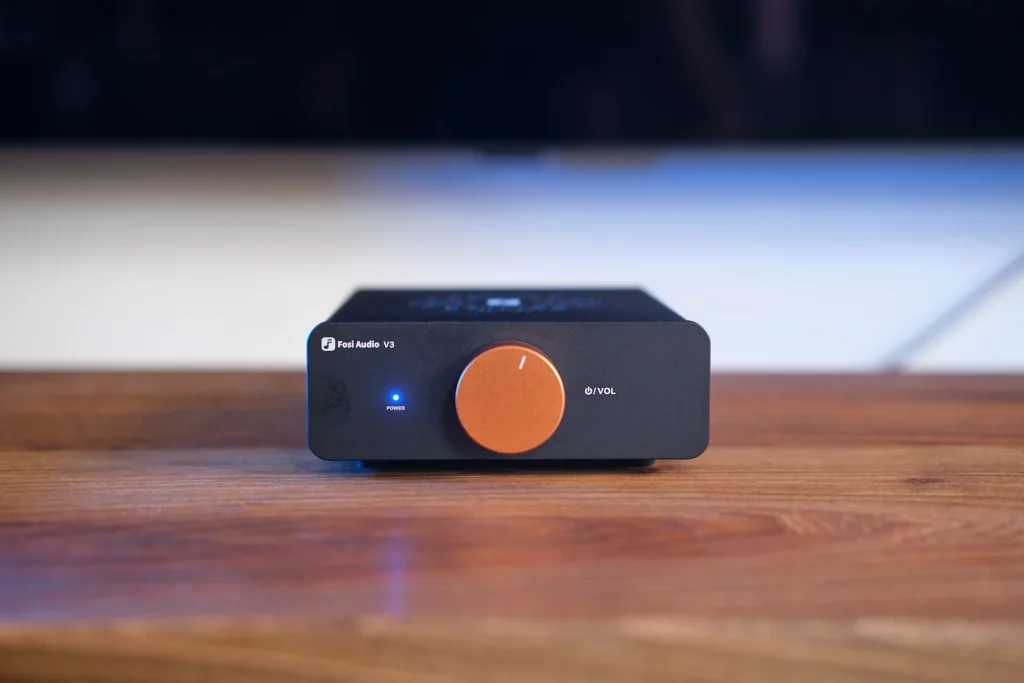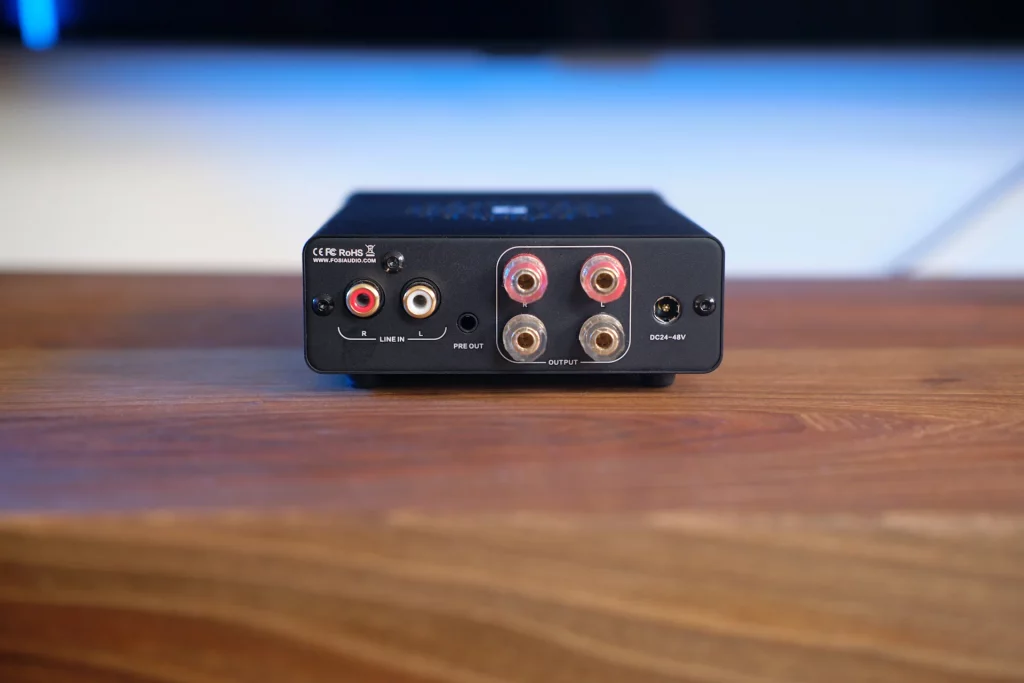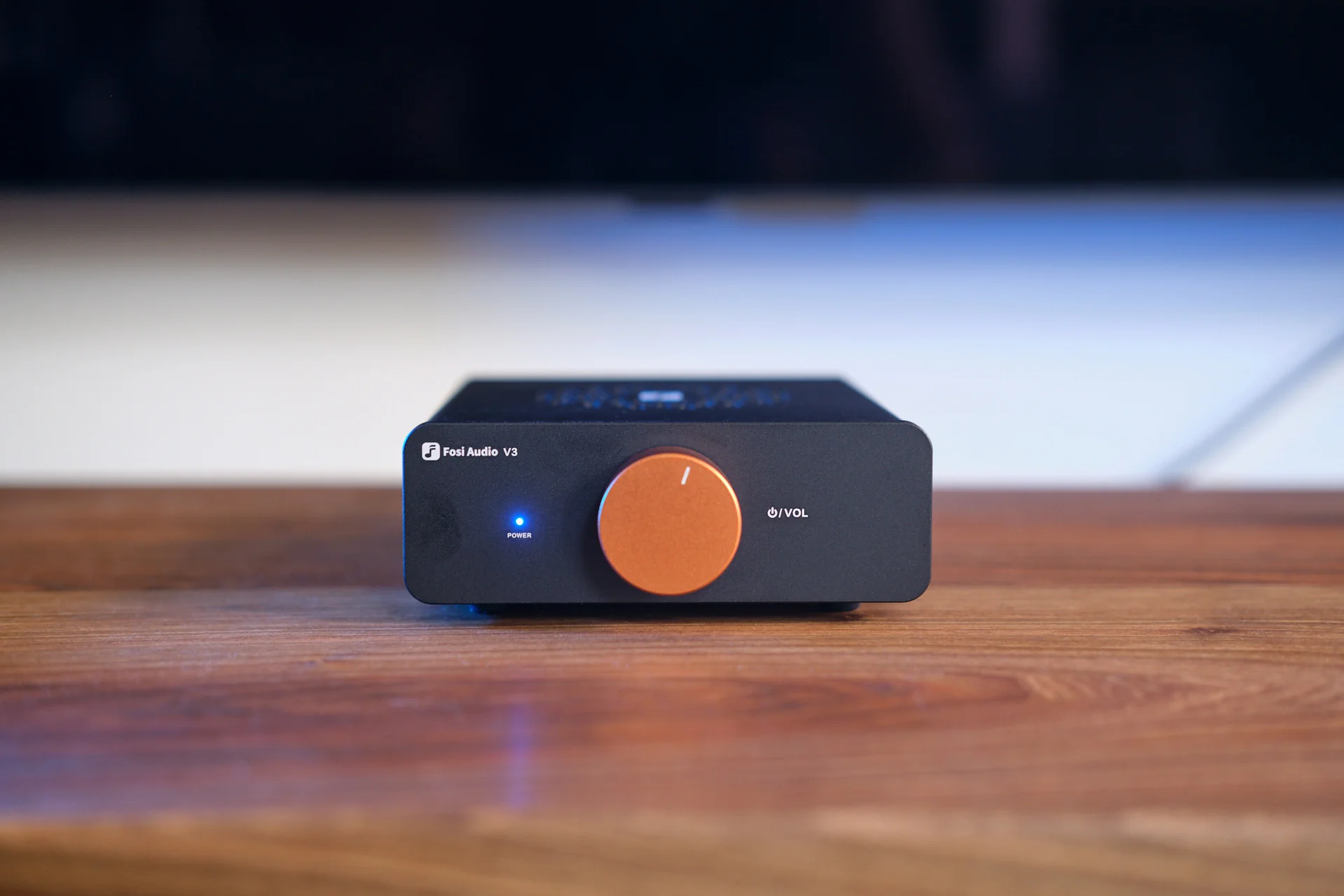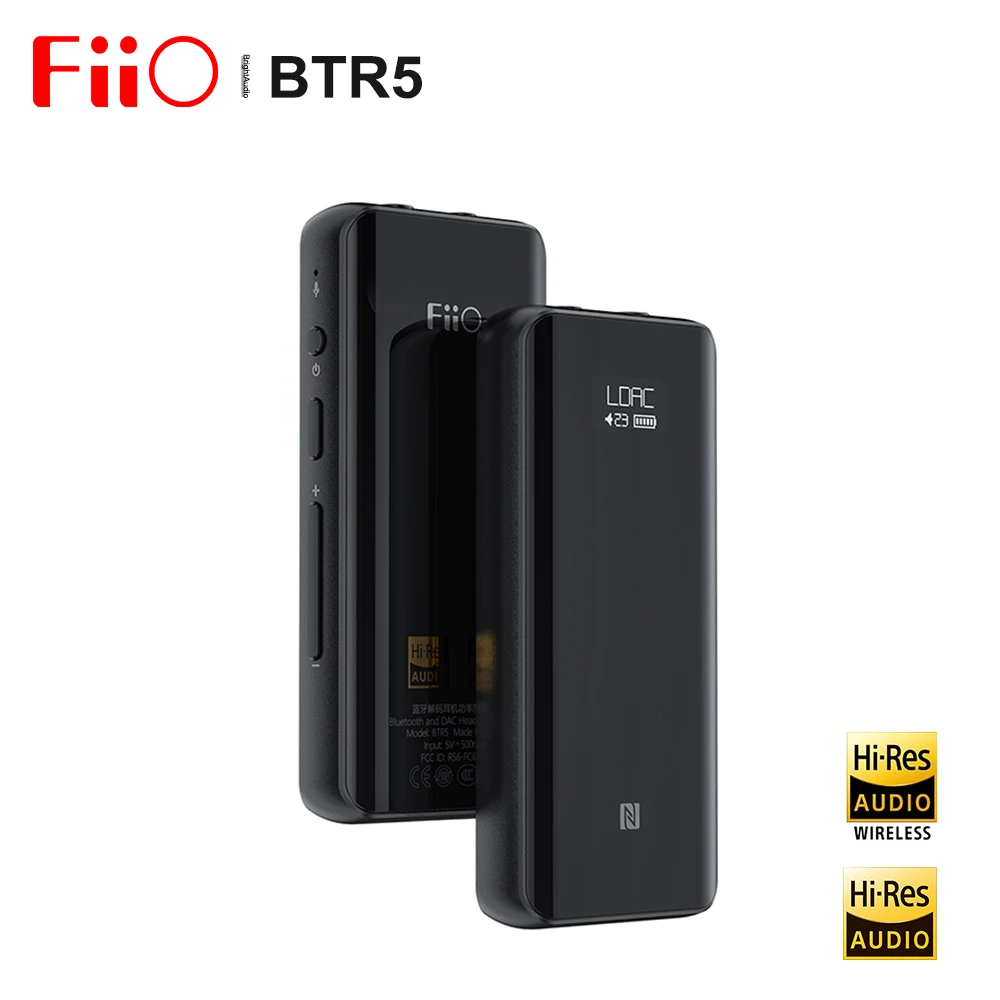Fosi Audio made a blast online with V3 – a small and very affordable amplifier that everyone claims can tackle much more expensive amps at a fragment of their cost. Let’s find out if there’s any merit to that story.
Build and Features
V3 is a small device that can fit in the palm of your hand, yet it’s a very well-made one. Aluminium is used all around and it feels sturdy enough. Even the volume knob, which takes the central spot on the front of the unit. is machined out of aluminium. Knob is black by default but you can pay extra ten dollars if you want an orange version. Style and its worth is always a personal thing so I won’t comment any further and you can decide for yourself which one you want. Aside from the volume knob that doubles as the on-off switch, there are no other buttons or switches. There is no remote control either so I suppose this amplifier is best suited for a desktop setup.

Moving to the back we can see one set of RCA analog inputs, preamp output in the form of a 3.5 mm jack, and binding posts to connect your speakers. This simplicity will be perfectly fine for many but not for all, and that is fine – not all products are made to appeal to everyone. On the right side of the back panel, you can see a power input that accepts DC voltage from 24 to 48 Volts, meaning that there is a power brick bigger than the amplifier itself juicing it up.

When it comes to the power supply, you can choose between 32 V and 48 V when purchasing. Both of these are rated at 5 amperes. Depending on which one you opt for, possible output power can vary and you can find all that in the spec table at the bottom of the page. I opted for the higher voltage version so all tests and impressions in this review are based on the 48 V / 5 A version.
In the heart of the device, there is a Texas Instrument TPA3255 chip amplifier and Fosi Audio claims they made it output up to 280 W per channel in the best-case scenario which includes a 4 Ohm load and 48 V / 10 A power supply. With the one I have, that number falls to 230 W which is still a more than respectable number. Anyways, all those numbers aside, let’s find out how this amplifier performs in real-life use.
Sound
Fosi Audio V3 is a typical representative of the uncolored sound. Everything from the bassline to the highs is well-judged and you simply can’t pick a part of the sound spectrum that is asking for your attention more. This is a really good start given that affordable class D amplifiers used to sound lean and detailed but often dry or outright harsh. That’s certainly not the case with V3. This amplifier manages to produce music that sounds as a coherent whole and not just some of its parts. Male vocals sound full and believable, vocals in general don’t exhibit signs of sibilance or any other nasty characteristic. I moved to some jazz instrumentals just to notice that all instruments sounded natural too – trumpets are open but not harsh, string plucks are clean but not too edgy, and cymbals are crisp but also fluid enough. Go ten years into the past and even much more expensive class D amps would struggle to sound this natural.
Almost perfect tonality aside, what about other aspects you may ask? For one, the soundstage is decent. It’s not particularly big or airy but it’s not flat either. While sheer dimensions might be modest in absolute terms, it’s worth mentioning that no amplifier near this price is doing any better in that regard. It’s also worth mentioning that V3 layers really well, and separates instruments skilfully. This made for a well-organized soundstage with precisely pinpointed instruments and vocals. For the effect that the soundstage is enveloping your speakers completely and blasting sound outside of their physical boundaries, you would have to look too much, and I mean much, pricier amplifiers.
Finally, microdynamics is decent and this is one lively sounding amplifier. Big dynamic swings are not done with the scale and authority that one might expect from this power rating. In fact, there are less powerful amplifiers that will sound bigger and present a much bigger dynamic scale with more ease. Fosi Audio V3 is simply a clean and lively-sounding amplifier that is not meant to rock your house or impress you during Hans Zimmer’s movie compositions. For this to happen, the amplifier needs to have a much beefier power supply with greater current output and greater drive into impedance dips – which are often located in the bass region of a speaker and consume an unproportionate amount of energy. This fact will not take even a notch on my impression of Fosi V3, nor decrease its score. In fact I wouldn’t even mention it if some people are not reading into numbers too literally, believing that every Watt is the same no matter how it came to be.
Comparison
SMSL A300 is a pricier amplifier at 200 dollars. It also comes more feature-packed with an internal DAC of a lousy quality that you probably won’t use and a remote control that I appreciate. Those differences aside, let’s talk about how they compare sonically. Starting with similarities, they both sound very clean, precise, and revealing. Fosi Audio V3 has a slightly more natural and coherent presentation, while SMSL A300 is a bit livelier and more sparkly in highs. I slightly preferred SMSL’s presentation but you may disagree. Depending on your own preferences and system matching you might prefer the milder approach of V3.
Topping PA7 Plus is almost five times the price and offers the same kind of functionality, meaning no remote, and no extra features to talk of unless you coun balanced inputs. That said, PA7 Plus does sound even cleaner and even more revealing. It also develops a bigger soundstage – both wider and deeper – with a darker background. Listen to it for some time and go back to Fosi Audio V3 – it will sound smaller and more congested. Is this worth five times the price? I can’t answer that for you since we all have our level of emotional and financial investment in this hobby.
Conclusion
Fosi Audio V3 is a well-made and really good-sounding desktop amplifier. I’ve seen that the online community is going nuts over its sound and almost perfect measurements. I can confirm that V3 sounds very clean and very well-balanced, but is it really the giant killer it is made to be? Not really. High-tier amplifiers do all of this but with a more impressive scale and authority. So let’s look at that clear-headed – this is a one hundred dollar amplifier that does most of the things well, some of them even really well, and for a noticeable upgrade over V3 you would have to spend five times more. It might not be a giant killer but it sure is a killer value.
| FOSI AUDIO V3 – CHARACTERISTICS |
|
Chipset: TI TPA3255 |






